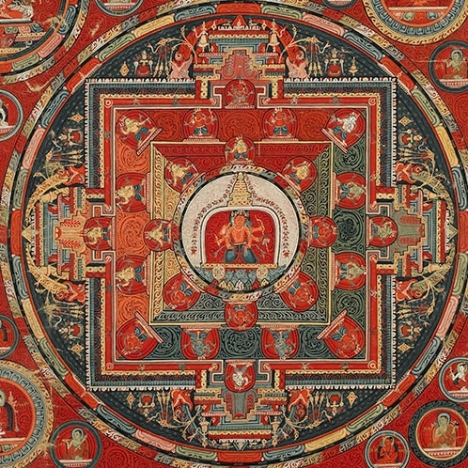
Mandalas are among the most recognizable and visually evocative objects of power in Tantric Buddhism. They not only represent a deity and his or her perfect palatial abode, but also make this ideal cosmos into a living presence in this world. Practitioners use mandalas as aids for visualization in meditation, in order to cultivate the mind of a deity. Mandalas can also be used as devices for instruction, as ritual objects, or as protective talismans. Most of the mandalas on view in the Rubin take the form of a two-dimensional painting. However, mandalas are intended to represent the full three-dimensional form of the deity’s realm, and are often created in sculptural form, in gold, wood, clay, sand, or in this case bronze.
This mandala, from 12th-century India, takes the shape of a lotus. The lotus is a symbol of purity, and the aim of visualization practices is to recognize that the apparently impure world is, in reality, pure. This sculpture can close into a bud. The outside features the eight cemetery grounds and the eight great tantric adepts, known as mahasiddhas. These figures, the founding masters of Tantric Buddhism, abandoned the comfort of monastery living for the margins of society and turned to places of death and impurity as sources of spiritual power. By meditating in a cemetery, they realized the ultimate non-duality of life and death. The lotus bud opens into a blossom, to reveal the sources of power found within. A sculpture of the divine couple Hevajra and Nairatmya was originally at the center of the mandala and signified sources of power for all other figures within the mandala, including the eight dancing yoginis. The Hevajra Tantra is a source of magical spells and practices aimed at the transcendent goal of liberation, as well as worldly aims such as making rain, curing illness, finding lost things, and subduing enemy armies. The lotus grows out of a stalk on which two nagas or snake-beings prepare the vajra throne of the Buddha, the foundation of the activities of all who inhabit the upper blossom. According to Tantric Buddhism, while the Buddha appeared to be a monk meditating under the Bodhi Tree, he secretly departed to receive initiation in the esoteric tantric rites that were necessary to achieve full awakening.
Come view our Art of the Week on the exhibition Gateway to Himalayan Art.
H 12 5/8 x W 7 5/8 x D 7 5/8 in.
C2003.10.2, HAR65207
- https://dev.rubinmuseum.org/images/content/716/c2003.10.2har65207-(open-d)__zoom.jpg
- https://dev.rubinmuseum.org/images/content/716/c2003.10.2har65207-(closed-b)__zoom.jpg
- https://dev.rubinmuseum.org/images/content/716/c2003.10.2har65207-(open-d)__zoom.jpg
- https://dev.rubinmuseum.org/images/content/716/c2003.10.2har65207-(closed-b)__zoom.jpg

__slider.jpg)
__slider.jpg)
